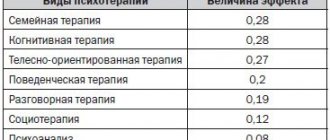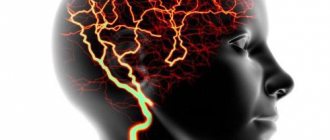| Dependent personality disorder | |
| ICD-10 | 60.7 |
| ICD-9 | 301.6 |
| eMedicine | |
| MeSH | D003859 |
Dependent personality disorder
;
dependent personality disorder
;
outdated personality disorder of asthenic type
;
outdated asthenic psychopathy
is a personality disorder characterized by an increased feeling of helplessness, incompetence and inability to live without the support of other people, the need for which is felt most of the time. Included in ICD-10 and DSM-IV.
Types of disorder
Organic mental disorders are divided into the following types and forms:
- Organic emotionally labile asthenic disorder - in this case, the pathology manifests itself with weakness and excessive manifestations of tearfulness, a decrease in the level of motor skills and attacks of loss of consciousness, there is dizziness and rapid fatigue (asthenia).
- Asthenic organic disorder is a persistent change in the psychological state of the patient, combining both symptoms inherent in neuroses and cerebrasthenic pathologies, which are inherent in any lesions of the cerebral vessels. This form of disorder manifests itself at all stages of the disease, up to the final stage - vascular dementia.
- Symptomatic mental disorders are a typical phenomenon for the somatic nature of pathologies, manifesting themselves in the inability to concentrate attention for a long time and in rapid fatigue; the patient’s memory is weakened and the psyche is excessively vulnerable. Along with this, the patient may suffer from disturbances in sleep patterns and hypertension.
- Anxiety disorder - this form of pathology manifests itself with tremors and a feeling of trembling, rapid contraction of the heart muscle and pallor of the skin, dry mouth and attacks of anxiety and unreasonable fear.
- Schizophrenia- like organic disorder of personality and behavior - in this case, the patient is diagnosed with attacks of delirium, constant or periodic, negative in nature changes in the structure of the personality, the development of delusional thoughts and flashing pictures, most often on religious themes. Alternatively, the patient may develop disturbances of consciousness and paranoia, accompanied by attacks of ecstasy and excessive excitement.
- Exogenous-organic type of disorder - this form of pathology is characterized by manifestations of excessive suspiciousness and intellectual disorders, increased uncontrollability and aggressiveness, and a certain anger.
- Depressive personality disorder of organic etiology - this pathology is found in the practice of both general practitioners and neurologists. It is characterized by somatoneurological symptoms, which will prevail over the mental manifestations of the disorder. In this case, doctors diagnose the patient with excessive and rapid fatigue, memory and appetite disorders, a feeling of dryness in the mouth and an increased urge to urinate.
- Affective type of disorder - most often occurs against the background of a malfunction of the endocrine system, when the patient stops taking hormonal drugs, or as a result of the development of tumors in the brain, head injuries.
- speech disorder – this type of pathology can occur in both adults and children. The root cause of the development of this form of the disease is atherosclerosis, which affects the blood vessels of the brain, diabetes mellitus or hypertension.
- Residual organic disorder - most often this pathology manifests itself in childhood or adolescence and is a consequence of the organic nature of damage to the central nervous system. The presented form of disorder manifests itself in the idea of mental retardation and inadequate reactions of psychological theology.
- A disorder caused by a vascular nature , developing as a result of various vascular pathologies affecting the brain - hypertension, previous heart attack, stroke, etc. This disease differs from other similar diseases in the absence of psychopathological signs of a neurological disorder.
- Disorder of complex genesis - the diagnosis is made by doctors when there is more than one reason for the development of a personality disorder of organic etiology.
Symptoms
The main problem of this pathology is that it is difficult to identify astheno-anxiety syndrome. Signs of this condition are characteristic of a large number of different diseases of the nervous system. In fact, the symptoms of asthenia are subjective for each specific case. The syndrome can be suspected if the following signs are detected in a person:
- Apathy that progresses over time. The symptom appears almost immediately. The patient loses interest in his own work and favorite activities.
- Severe weakness. The patient himself and those around him cannot explain the appearance of this condition.
- Sleep disturbance. A person may wake up constantly, have nightmares, or not sleep at all at night.
- A sharp decrease in performance. The patient does not have time to do anything, becomes nervous and irritable.
- Daytime sleepiness. The sign can be noticed at a time when a person should still be cheerful and full of energy.
- Periodic surges in blood pressure (blood pressure).
- Malfunction of the gastrointestinal tract and genitourinary system. The patient may notice problems in the functioning of the liver, kidneys, lower back pain, and disturbances in the urination process.
- Periodic shortness of breath.
- Memory impairment.
- Change in character for the worse.
- Phobias.
- Tearfulness.
The signs of asthenic neurosis can be considered in the context of two types of disease: hypersthenic and hyposthenic. In the first case, the patient experiences increased excitability. Against this background, various types of irritants become unbearable for him: bright lights, loud music, screams or laughter of children, noises. As a result, a person tries to avoid these factors and often suffers from headaches and vegetative-vascular disorders.
The hyposthenic form of asthenic neuroses is characterized by the patient’s low sensitivity to any external stimuli. It is characterized by a person’s depressed state, lethargy, passivity, and drowsiness. Often patients with this type of asthenic disorder experience apathy, unmotivated sadness, anxiety, and tearfulness.
In children
Children of all ages, including infants, are susceptible to asthenic syndromes. The baby becomes excitable, constantly mischievous, and eats poorly. A manifestation of asthenia in infants is causeless tearfulness, fear of any sounds, even subtle ones. A child may get tired from being rocked in their arms for a long time and communicating with adults. It is difficult to lull a baby with asthenia to sleep; he takes a long time to fall asleep, is capricious, and constantly wakes up at night. It is important to consider that children with this syndrome are able to fall asleep faster in the absence of their parents. You should leave the baby in the crib and leave his room.
Psychological exhaustion of a child can provoke registration in kindergarten. Separation from mother is very stressful for many. In addition, asthenic neurosis can develop against the background of early entry into school (from 6 years of age). The child is faced with a large number of new requirements and rules. He needs to sit quietly in class and remember new information. As a result, asthenia develops. Symptoms of this syndrome in children of preschool and primary school age are the following:
- nervousness;
- isolation;
- dizziness;
- increased fatigue, the child may be indifferent to favorite activities and toys;
- poor memory;
- difficulty concentrating;
- headache from loud noises;
- photophobia;
- fear of strangers;
- poor appetite.
Adolescents can also develop encephalasthenic syndrome and other forms of this disorder. Symptoms of pathology characteristic of children of senior school age:
- Violation of rules of behavior in lessons, generally accepted norms of communication with others:
- rudeness towards peers and adults;
- poor appetite;
- recurrent headaches;
- weakness;
- apathy;
- poor performance at school;
- problems with concentration;
- absent-mindedness;
- conflict, desire to argue on any issues;
- increased fatigue;
- instant changes in mood;
- sleep problems.
All these manifestations of asthenic syndrome in children can be combined with signs of concomitant diseases that caused the disorder. It is important to consider that asthenia is a whole complex of symptoms that progress over time. If a child has 3 or more signs of the syndrome, you should seek help from a neurologist, pediatrician or child psychiatrist. It is difficult to diagnose asthenic disorders in children, because some of their symptoms do not differ from the personal characteristics of young patients.
Asthenic syndrome - what is it?
Organic emotionally labile disorder
By this term, doctors mean a painful condition in which the patient exhibits constant or de-periodic attacks of incontinence, nervousness and rapid fatigue, physical discomfort, and attacks of pain of various natures.
In the medical field, this disorder is known as asthenia - this disorder is most often a consequence of a disease in its severe form - hypertension and a malfunction in the blood flow of the circulatory system that feeds the brain, stroke, and so on.
In terms of characteristic symptoms, this pathology manifests itself as general weakness and photophobia, headache attacks and rapid fatigue. The patient's motor and motor activity decreases, concentration fails, and the level of irritability and tearfulness increases. Regarding the reasons that provoke the development of this form of organic disorder, doctors identify the following:
- head injury;
- pathologies of the vascular system;
- HIV and epilepsy;
- viral or bacterial theology of neuroinfection;
- diagnosis of systemic and somatic pathologies, neurosyphilis and neuroAIDS;
- neoplasms affecting the brain.
With regard to diagnosing this form of disorder, the main efforts are aimed at assessing the patient’s condition, the severity of the damage to his personality and establishing the root cause that provoked this condition.
Treatment is a course of complex therapy and, first of all, doctors prescribe medications from the group of nootropics and nonspecific stimulants. In addition, doctors prescribe vitamins and a course of physical therapy.
Asthenic disorder of organic nature
Organic asthenic personality disorder is a psychological condition of a persistent nature with cerebrasthenic and neurosis-like symptoms. Develops against the background of brain diseases of vascular etiology.
At the initial stages of the disease, the disease manifests itself in the form of a cerebral form of asthenia, but in the absence of treatment, it passes to the stage of vascular dementia.
The reasons for the development of this pathology may be a hereditary predisposition and a severe emotional experience suffered by the patient, as well as the lack of adequate opportunity to relax, an unfavorable climate in the family and at work, and large volumes of work.
Organic asthenic personality disorder manifests itself with the following symptoms:
- the manifestation of a pronounced asthenic disorder is also a clear manifestation of nervousness and discomfort at the physical level, attacks of pain of different nature and localization;
- loss of strength and fatigue, attacks of tearfulness;
- heightened perception of external stimuli and headache attacks;
- sleep disturbance and other symptoms.
Doctors make the diagnosis of organic asthenic disorder in cases where the patient does not reveal deep pathological disorders of consciousness.
Treatment of organic personality disorder begins with primary diagnosis - this is a competent and correct interpretation of the information received from the patient and evaluation of test results. The main diagnostic methods are determining the psychological portrait of the patient, collecting an anamnesis of the course of the disease, laboratory tests and analysis of all subjective complaints, measuring blood pressure and pulse rate. Additional research methods are ECHO-cardiogram and ultrasound.
The treatment process is a rather long and labor-intensive process aimed at eliminating negative manifestations and eliminating all the root causes that provoked the disease.
In order to increase working capacity and when diagnosing chronic fatigue, adaptogens, tonic drugs that increase the body's resistance to negative external and internal factors are prescribed. In addition, nootropics and antidepressants of the inhibitory group can be prescribed.
The forecasts of modern doctors are positive, but only with timely diagnosis and treatment of the pathology. In the absence of timely treatment, the disease progresses to the stage of vascular dementia, in which the prognosis for the patient is very negative.
Emotionally labile asthenic psychopathy
Speaking about what emotionally labile and asthenic disorders are, in each case they are an organic lesion caused by somatic or infectious diseases of the central nervous system and brain.
Their essence is that both the vascular system of the brain is affected and, as a consequence, the psychological and emotional state is disrupted, provoked by excessive stress, trauma, nervous strain, encephalitis or a brain tumor.
Symptoms include fatigue and weakness, attacks of headache and irritability, decreased motor activity and attention, and increased blood pressure.
Diagnosis is carried out on the basis of collecting the patient’s medical history and drawing up his psychological portrait; the causes of the pathology are identified. Treatment of the disease is medication; a course of psychological adjustment is also prescribed.
Organic emotionally labile asthenic disorder is differentiated from a disorder of a neurotic nature such as neurasthenia or other specific disorders that are caused by stress or external and internal psychological factors, but in this case there is no characteristic history of pathology.
The differences between asthenic disorder and the clinical manifestation of neurasthenia, provoked by physical and mental overload, are identified after identifying the root cause that provoked the organic disorder.
Causes of asthenia in children
The appearance of asthenia in children is caused by the following factors:
- metabolic disorders;
- nutritional deficiency;
- excessive expenditure of physical energy.
In addition, acute exhaustion of the body is possible under the influence of such reasons as:
- pathologies of the gastrointestinal tract (colitis, gastritis, stomach ulcers, etc.);
- chronic infection (often asthenic syndrome develops after pneumonia);
- diseases of the blood and cardiovascular system;
- endocrine disorders (diabetes mellitus, hormonal imbalance);
- organic brain damage.
These diseases provoke exhaustion of the body, which leads to a neurotic syndrome in the child.
An increased risk of developing a mental disorder in children is observed in the presence of the following circumstances: heredity, frequent stress, unfavorable living conditions (poor environment, negative family environment), unbalanced diet.
Asthenia develops slowly. Therefore, the symptoms of the pathological condition become noticeable several months or years after, for example, a brain injury.
Organic anxiety disorder
Most depressions of an organic nature begin with the development of a state of anxiety. Thus, anxiety and panic attacks in half of the cases are inherent in acute circulatory disorders in the brain and when diagnosing myocardial infarction.
The reasons that provoke this disorder are cardinal and cerebral disorders, vascular pathological changes in the brain, disturbances in the functioning of the endocrine system, and head injuries.
Symptoms of the pathology manifest themselves in the form of attacks of anxiety and tremor, tremors in the epigastric region and spasms in the navel, tension in the muscle ring around the scalp, attacks of tachycardia and increased breathing, pallor of the skin or their redness, dry mouth.
The course of treatment involves taking tranquilizers that have an anxiolytic effect - most often Mebicar, Buspirone. The duration of treatment is no more than a two-week course.
The therapeutic course can be supplemented by taking antipsychotics and antidepressants at night.
Consequences of ANS, forecasts
If such serious ataxia is neglected and there is no adequate and timely treatment, there is a chance of becoming seriously depressed, and in some cases, desires to end life may appear.
Basically, people during a period of disorder are quite able to get rid of it on their own. But it is very difficult to get out of a complication that has developed into deep depression without the help of a qualified specialist who will conduct an examination and prescribe a comprehensive course of treatment.
Not paying attention to the manifestations of dysphoria in children entails undesirable changes in the endocrine system and possible dysfunction upon reaching puberty. Adults who suffered such disorders in childhood may have certain problems with reproduction.
Delusional psychopathy
Organic delusional personality disorder is a pathology of a psychological nature in which the patient has persistent or recurrent, incorrect and false ideas and beliefs that dominate the overall picture of the disease.
The causes of the disease have not yet been precisely established by doctors. According to some scientists, the disease can be hereditary in nature, have a biological nature when there is an imbalance in the level of neurotransmitters in the body, and there may also be the influence of external factors - alcohol abuse and stressful situations, depression, head injuries.
The main symptoms are constant attacks of delirium, and in the case of an acute form of the disease, disturbances in the functioning of the nervous system also manifest themselves.
The chronic form of the disease will manifest itself with negative symptoms over a fairly long period of time.
The pathology is diagnosed based on interviewing the patient and collecting an anamnesis of the course of the disease; neurologists or psychiatrists note those signs that are not characteristic of schizophrenia - the patient’s pursuit of a delusional idea or thought.
Treatment of the disorder is complex; the patient undergoes both medication and psychotherapeutic behavior modification.
The main task of psychological adjustment is to switch the patient’s attention from the subject of his disorder to other, real goals.
The medical course of treatment involves prescribing and taking the patient antipsychotics, and if depression is diagnosed, tranquilizers and a course of antidepressants.
When a severe form of the disease is diagnosed, the patient is placed in a hospital until his condition is completely stabilized.
Diagnostics
Psychotherapists use a range of studies and tests:
- clinical diagnosis - a survey, collection of anamnesis and follow-up, which is carried out by a therapist, neurologist and psychiatrist. Each specialist builds a conversation in such a way as to identify the symptoms of his spectrum. Diagnosis is complex;
- the physical method is carried out by a therapist, its purpose is to examine and evaluate the functioning of the internal organs, followed by an appointment with a neurologist to identify symmetry, reactions to light and sound, analyze the correspondence of reflexes to the patient’s age category, and identify developmental delays;
- psychodiagnostics is carried out by a psychologist, the method is aimed at identifying instability of attention, disorders in long-term and short-term memory, disorders of logical and spatial thinking. Patients with astheno-neurotic syndrome, by the end of the conversation with a psychologist, demonstrate fatigue, exhaustion, their speech is confused, and there is no logical chain in their judgments;
- The instrumental method involves conducting a number of studies (rheoencephalogram, magnetic resonance imaging, X-ray, ultrasound of the head and neck, etc.). Patients with asthenic syndrome have obvious deviations from the norm in the functioning of the vascular system, an imbalance of nerve impulses, pinching or neoplasms in the neck or brain, etc.;
- laboratory tests, the purpose of which, through a general blood test and biochemistry, is to exclude various infections and diseases that can masquerade as mental and nervous disorders.
If symptoms unusual for central nervous system diseases occur, it is recommended to undergo additional tests to exclude the presence of diseases of the hematological, immunological and infectious spectrum.










